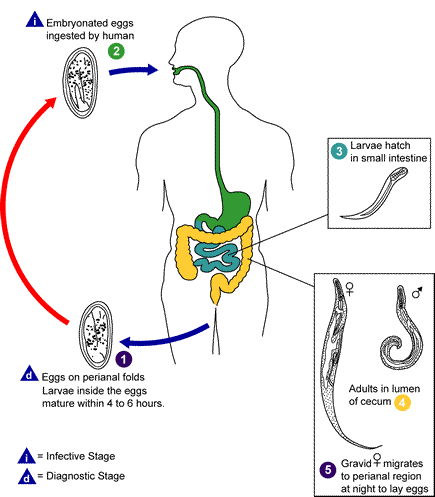Enterobiasis pathophysiology
|
Enterobiasis Microchapters |
|
Diagnosis |
|---|
|
Treatment |
|
Case Studies |
|
Enterobiasis pathophysiology On the Web |
|
American Roentgen Ray Society Images of Enterobiasis pathophysiology |
|
Risk calculators and risk factors for Enterobiasis pathophysiology |
Editor-In-Chief: C. Michael Gibson, M.S., M.D. [1]; Associate Editor(s)-in-Chief: Furqan M M. M.B.B.S[2]
Overview
Enterobius vermicularis is usually transmitted via the feco-oral route to the human host. It reproduces in the small intestine of humans only. The gravid female worm lays eggs in the perianal area usually at night and causes pruritus. In addition to the fingernail contamination, the infective eggs can be transmitted via the dust and fomites.
Pathophysiology
Pathogenesis
- It is postulated that Enterobius vermicularis triggers an inflammatory response which is associated with the low-grade eosinophilia.
- Allergic response to the worm protein is considered the cause of pruritus; usually pruritus ani (perianal pruritus).[1]
Lifecycle
The lifecycle of Enterobius vermicularis is completed in the human host and comprises of the following stages:[2][3]
- The infective eggs of E. vermicularis are ingested via contaminated hands or fomites (clothing, toys, bed, furniture, animals' fur etc). The eggs mature into adult Enterobius in 15-40 days.
- Male adult larvae fertilize the female (in lower ileum) and are passed out in stools without producing symptoms. Adult females settle in the lower ileum, caecum, appendix and ascending colon. The gravid worm migrates from the colon to the rectal area. At night eggs laid on the perianal skin by the uterine contraction(s) of the gravid worm.
- At oviposition, the eggs are immature and non-infective. They become infective within 6 hours at body temperature.
- In cool, moist environment with little ventilation eggs remain viable for up to three weeks. However, the infectivity decreases with time. Eggs do not tolerate heat that well which might be the reason that enterobiasis is more common in temperate than tropical climates.
- In rare cases, pinworms are found in the vagina and even more rarely in the uterus, fallopian tubes, liver, and peritoneum, but the worms cannot survive long in these places.
The image shown below depicts the life cycle of the pinworm.[4]

Mode of Transmission
E. Vermicularis is transmitted via these four modes:[2]
- Direct infection from the anal and perianal regions by infected fingernails.
- Exposure to viable eggs on fomites (clothing, toys, bed, furniture, fur of pets etc).
- By dust contaminated with embryonated (infected) eggs.
- Retroinfection; migration of the larvae into sigmoid colon & caecum after hatching on the anal mucosa.
Image
-
Life cycle of Enterobius vermicularis, otherwise known as the human pinworm. From Public Health Image Library (PHIL). [5]
References
- ↑ Katz, Michael (1989). Parasitic Diseases. New York, NY: Springer US. ISBN 978-1-4684-0327-5.
- ↑ Jump up to: 2.0 2.1 Cook GC (1994). "Enterobius vermicularis infection". Gut. 35 (9): 1159–62. PMC 1375686. PMID 7959218.
- ↑ Caldwell JP (1982). "Pinworms (enterobius vermicularis)". Can Fam Physician. 28: 306–9. PMC 2306321. PMID 21286054.
- ↑ "CDC - Enterobiasis - Biology".
- ↑ "Public Health Image Library (PHIL)".
![Life cycle of Enterobius vermicularis, otherwise known as the human pinworm. From Public Health Image Library (PHIL). [5]](/images/5/53/Pinworm05.jpeg)